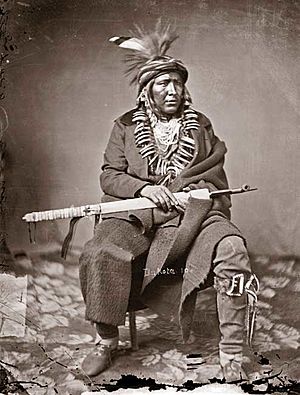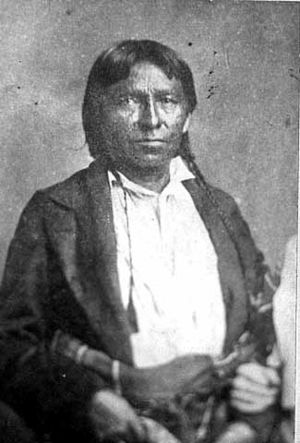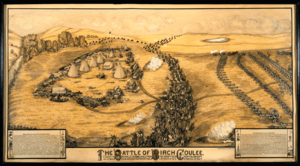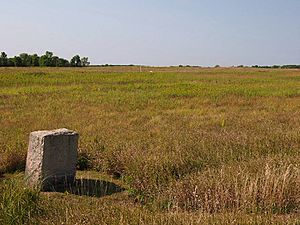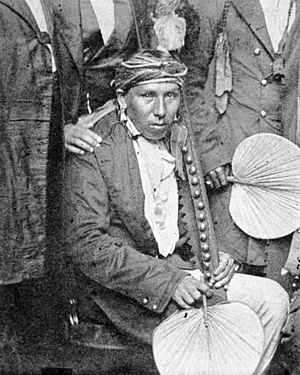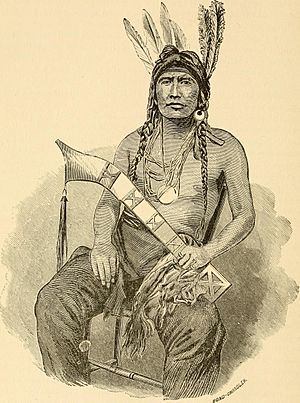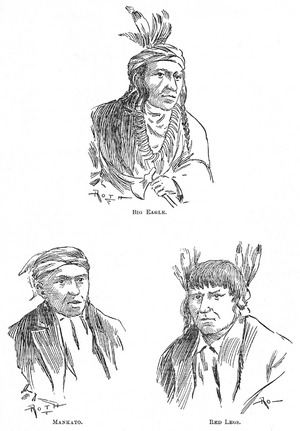Big Eagle facts for kids
Big Eagle (in the Dakota language: Waŋbdí Táŋka), born around 1827 and passing away in 1906, was an important chief of a group of Mdewakanton Dakota in Minnesota. He was a key leader during the Dakota War of 1862.
After the war, Big Eagle gave up fighting and was sent to prison. However, President Abraham Lincoln later pardoned him in 1864. Big Eagle's own story, called "A Sioux Story of the War," was published in 1894. It's one of the most important accounts of the 1862 war from a Dakota person's point of view.
You can find Chief Big Eagle mentioned on historical markers at the Birch Coulee Battlefield in Minnesota.
Contents
Early Life and Leadership
Big Eagle was born in 1827 near Mendota, in what is now Eagan, Minnesota. He was related to Little Crow, another important Dakota leader.
In 1857, Big Eagle became the chief of his group, taking the name Waŋbdí Táŋka (Big Eagle) from his grandfather. Even though his group was not very large, he was seen as a "sub-chief" but also like a "general" because he led his own division of warriors.
When he was younger, Big Eagle often joined war parties against the Ojibwe and other groups. He was known for wearing six feathers in his headdress.
In 1858, he joined the Dakota farmers at the Redwood Agency, also known as the Lower Sioux Agency. However, he became less supportive of the farming way of life as the Dakota War of 1862 approached.
Trip to Washington, D.C.
Big Eagle traveled to Washington, D.C. in 1858. He was part of a group of Mdewakanton and Wahpekute Dakota leaders, including Little Crow, who went to discuss a treaty. Big Eagle was Little Crow's head warrior at this time.
During these talks, the Dakota leaders were pressured to sell a large part of their land to the United States. This land was north and east of the Minnesota River. This left the Dakota with a much smaller strip of land.
Big Eagle later said that selling this land caused a lot of unhappiness among his people. It made them move to the south side of the river, where there was little game to hunt. Many Dakota people were also encouraged to give up their traditional way of life and farm like white settlers, which many did not like.
The Dakota leaders spent over three months in Washington, D.C. This gave Big Eagle a chance to see American society.
Choosing a Tribal Speaker
In the spring of 1862, Big Eagle, Little Crow, and Traveling Hail were candidates to be the main speaker for the Mdewakanton tribe. Traveling Hail won the election.
Big Eagle explained that there were two main groups among his people: those who favored the white settlers' ways and those who preferred traditional Indian ways. Little Crow was seen as a traditionalist, while Traveling Hail and Big Eagle were favored by those who wanted to farm.
Big Eagle said that many people blamed Little Crow for selling the land, which might be why he lost the election. Big Eagle also noted that Little Crow was not the main chief of the Dakota at this time. That role belonged to Wabasha, who, like Big Eagle, was generally friendly with the white settlers.
The Dakota War of 1862
When the Dakota War of 1862 began, Big Eagle's village was near Little Crow's village.
Big Eagle took part in most of the major battles during the war. He led his group in the second battles of New Ulm and Fort Ridgely, as well as the Battle of Birch Coulee and the Battle of Wood Lake.
Big Eagle's Doubts About the War
In his own story, Big Eagle said he was not sure about supporting the war at first. He had been to Washington, D.C., and understood how powerful the U.S. government was. He knew that the Dakota would likely be defeated in the end.
He tried to tell his people this, but many of his own group disagreed. Some other chiefs even told his men to shoot him if he refused to lead them.
Even after Little Crow decided to lead the war and ordered an attack on the Redwood Agency, Big Eagle did not want to kill settlers. He went to the agency to try and save the lives of two friends. He believed other Dakota warriors did the same.
After returning to his village, Big Eagle saw that many of his men wanted to join the war. He decided to lead them, saying they would fight bravely as Dakota warriors.
Lives Saved by Big Eagle
Big Eagle was careful about claiming he saved white settlers' lives because many warriors made false claims after the war. However, he did mention saving George H. Spencer, a store clerk, during the attack on the agency.
His obituary in 1906 also stated that he saved the Alvin family during the attack on New Ulm. He warned them to go to New Ulm quickly, and they were chased by hostile Indians but made it to safety.
Battles at New Ulm and Fort Ridgely
Big Eagle fought in the second battles at New Ulm and Fort Ridgely. At New Ulm, he had only a small group of his men. He said there was no single commander for the Dakota forces there. Instead, sub-chiefs and head warriors led the groups.
The second attack on Fort Ridgely was a much larger event. Big Eagle said that if it weren't for the cannons at the fort, the Dakota might have captured it. He noted that the cannons scared them but didn't kill many Dakota warriors. He believed the white soldiers fought bravely.
Battle of Birch Coulee
War Council and Plan
On August 31, 1862, Dakota leaders discussed their next steps. They decided to split into two groups. Big Eagle joined Gray Bird, Mankato, and Red Legs, leading over 200 warriors to collect supplies from abandoned villages.
On September 1, scouts spotted a group of soldiers from Fort Ridgely. Big Eagle and the other leaders decided to surround the soldiers' camp that night and attack at dawn. They thought 200 warriors would be enough. Big Eagle led his men from the west, while others took positions around the camp.
The Ambush
Just after 4 AM on September 2, the Dakota warriors began their attack. They quickly killed many soldiers and horses. However, the soldiers were ready and fought back, preventing the Dakota from taking the camp.
Big Eagle described how the Dakota fought carefully, using the grass and coulees (small valleys) for cover. They could even get water and food from their women who came close to the battlefield. He said they lost very few men.
Arrival of Help
The battle turned into a long siege. Big Eagle said his men wanted to charge the camp, but then they heard that more soldiers were coming. Colonel Samuel McPhail was leading 240 men with cannons to help the trapped soldiers.
Mankato, a brave Dakota leader, took about fifty men to meet the new soldiers. They made a lot of noise, making the white soldiers think there were many more Dakota warriors. The soldiers stopped and began to dig defenses. Mankato's group tricked them, and the soldiers retreated.
The Battle of Birch Coulee continued until September 3, when Colonel Henry Hastings Sibley arrived with a large force and more artillery. The Dakota warriors slowly left the field. Big Eagle said the cannons fired at them as they left, but they caused no harm.
Battle of Wood Lake
Big Eagle also led his group in the Battle of Wood Lake, which was another major battle of the war.
Surrender and Imprisonment
Big Eagle surrendered at Camp Release in September 1862. He later said he regretted this decision. He had been told he would only be held as a prisoner of war for a short time.
Instead, he was imprisoned and tried. He spent three years in prison at Davenport, Iowa, and Rock Island, Illinois. During his trial, many white prisoners testified, but none could say that he had murdered anyone or deserved death. Big Eagle stated that if he had known he would be sent to prison, he would not have surrendered. He felt he had been treated unfairly.
Life After the War
Pardon and Release
Big Eagle was sentenced to death by a military court, but President Abraham Lincoln pardoned him in November 1864. He was released from prison on December 3.
Big Eagle's brother, Medicine Bottle II, was captured in Canada and executed in 1865.
His Famous Portrait
The well-known picture of Big Eagle was taken in the summer of 1864 while he was in prison at Camp Kearney in Davenport, Iowa. An assistant officer convinced Big Eagle, who was the highest-ranking Dakota in the prison, to have his photograph taken. Big Eagle agreed, but only after being paid $15.
Life After Prison
After leaving prison, Big Eagle joined his people at the Crow Creek Indian Reservation and later moved to the Santee Sioux Reservation in 1866. However, living on a reservation under the control of a government agent did not suit him.
In 1869, he left Santee and settled with his family near Birch Coulee. He became known as Jerome Big Eagle and was baptized as "Elijah."
In June 1894, Big Eagle was interviewed by a historian and journalist named Return Ira Holcombe. This interview took place in Flandreau, South Dakota, with the help of two interpreters. Big Eagle's story was published in a newspaper and later by the Minnesota Historical Society. It was the first detailed account of the Dakota War of 1862 told from a Dakota perspective.
In his story, 67-year-old Big Eagle said that he had found peace after the war. He had become a Christian and was friendly with both white and Indian neighbors. He was getting old but still worked and managed to live peacefully.
Big Eagle spent his last years in Granite Falls, Minnesota. He passed away on January 5, 1906, after a short illness.
"A Sioux Story of the War"
In June 1894, Big Eagle shared his story with historian Return Ira Holcombe. The story, titled "A Sioux Story of the War: Chief Big Eagle's Story of the Sioux Outbreak of 1862," was first printed in a newspaper on July 1, 1894. It was later republished by the Minnesota Historical Society.
Holcombe explained that Big Eagle agreed to tell his story so that people could understand the Dakota's actions during the war. Big Eagle was assured that no harm would come to him and that he would be reported accurately.
Holcombe was impressed by Big Eagle's honesty. He said Big Eagle was very open and answered all questions directly, like someone trying to tell the full truth. Holcombe found Big Eagle to be a great source of information, and his story contained many details that had never been published before.
Why His Story is Important
Big Eagle's story was the first complete account of the war from the viewpoint of a Dakota leader who fought alongside Little Crow. Historian Kenneth Carley noted that the interview was important because Big Eagle was a Sioux leader who participated in the councils where decisions were made.
Return I. Holcombe, the interviewer, was well-prepared for this task. He had served in the American Civil War and had worked at the Minnesota Historical Society, where he studied many historical papers.
Some people, like Samuel J. Brown, were doubtful about parts of Big Eagle's story. However, Holcombe himself was known as the first historian to write about the war in a fair and unbiased way.
Historian Kenneth Carley wrote in 1962 that Big Eagle's story is still widely used by writers today. It is essential for understanding both the Dakota and white perspectives of the war, as there is no other major account quite like it from an Indian leader.



